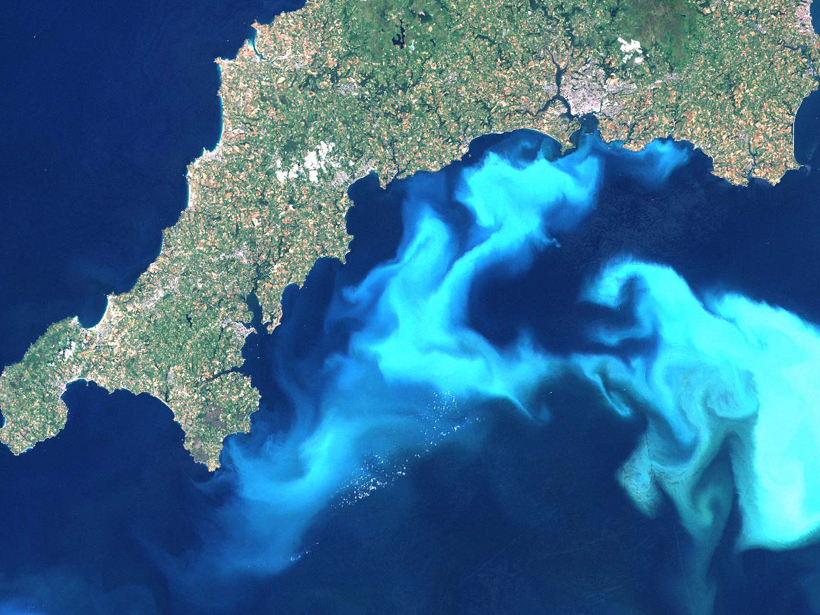Since the 1980s, scientists have explored the idea of fertilizing the oceans with iron to stimulate algae production, which would draw down carbon dioxide from the atmosphere. A new study in the equatorial Pacific casts doubt on this strategy, suggesting that iron fertilization may be ineffective for combating climate change.
Algae use carbon dioxide from the atmosphere for photosynthesis, storing the carbon in their bodies until they die and sink to the ocean floor. They require multiple nutrients to grow, including nitrogen, phosphorus, and iron. Rich upwellings in the Southern Ocean bring most of these nutrients to the surface, where ocean currents circulate them around the globe. Dust from the continents delivers iron to ocean waters.
Probing the Past
By studying the correlation between iron concentrations and past algae production, some scientists are seeking to better understand how iron fertilization would affect modern oceans as a geoengineering strategy. They have established that the cold, dry, windy conditions of the last ice age distributed a surplus of iron-rich dust to the oceans, but researchers continue to investigate whether this extra iron actually led to more algae (and increased carbon sequestration). A 2011 study in the Southern Ocean revealed that the surge in ocean iron during the last ice age corresponded to an algae production boom. This finding prompted a team of researchers led by Kassandra Costa, a graduate student at Columbia University’s Lamont-Doherty Earth Observatory in New York City, to look for a similar correlation in another iron-limited region. This study was recently published in Nature.
“Pretty much everyone agrees that dust fluxes were higher, but whether or not there was a productivity response is what people have been debating in the equatorial Pacific.”
“A lot of the debate about iron fertilization in the equatorial Pacific has been about the change in productivity rather than the change in dust,” said Costa. “Pretty much everyone agrees that dust fluxes were higher, but whether or not there was a productivity response is what people have been debating in the equatorial Pacific.”
The team collected sediment cores near the Line Islands in the central equatorial Pacific by lowering a PVC (polyvinyl chloride) tube within a steel tube 3000 meters to the seafloor. The researchers then analyzed time slices from the cores dating from the present and the last ice age. Concentrations of thorium isotopes correlated with iron-rich dust. Concentrations of opal, which comes from diatoms, a type of single-celled algae common in phytoplankton blooms, and barium, another known tracer of marine microorganism abundance, revealed how much surface productivity was present for each time period. Nitrogen isotope measurements allowed the investigators to determine how many of the nutrients supplied to the surface were actually consumed by algae.
It Takes More Than Iron
Data from the sediment cores led the researchers to infer that although 2 to 3 times as much iron-rich dust peppered the equatorial Pacific during the last ice age than today, levels of the nutrients nitrogen, phosphorus, and silica fell—and algae production lagged. The evidence suggests that the boom in algae production in the Southern Ocean during the same time period used up vital nutrients in southern waters, resulting in less to go around by the time currents reached the equatorial Pacific, the researchers report. “The equatorial Pacific didn’t really help reduce the CO2 during the last ice age,” said Costa. “It wasn’t an active participant in the carbon dioxide drawdown.”
“Net sequestration is not going to be what you think it is, because you’re depriving something way downstream.”
The study raises questions about whether sprinkling modern oceans with iron would actually be a viable way to sequester carbon dioxide from the atmosphere in the effort to mitigate climate change. This study shows that “you can’t just go out anywhere in the ocean and dump some iron in and expect to have an effect on climate,” said Phoebe Lam, an assistant professor of ocean sciences at the University of California, Santa Cruz. She said this and previous studies suggest iron fertilization may increase algae production in some regions, but the combined findings seem to suggest that nutrient circulation between the world’s oceans would prevent an overall increase in algae production and any total increase in the ocean’s ability to store carbon. “This paper is showing the net sequestration is not going to be what you think it is, because you’re depriving something way downstream,” said Lam.
—Shannon Kelleher, Writer Intern
Correction, 5 February 2016: An earlier version of this article incorrectly stated the name of the study site. This article has been updated to state that the team collected sediment cores near the Line Islands. The article has also been updated to include Costa’s full affiliation.
Citation: Kelleher, S. (2016), Iron fertilization might not make oceans better carbon sinks, Eos, 97, doi:10.1029/2016EO045631. Published on 5 February 2016.
Text © 2016. The authors. CC BY-NC 3.0
Except where otherwise noted, images are subject to copyright. Any reuse without express permission from the copyright owner is prohibited.

